This page lists Blockchain Analytics known issues and workarounds. For a list of bugs, new features, and other release information, see Release notes.
To filter this page, do one or more of the following: select a category, type a search term, or click a column heading to sort.
| Category | Subject | Description |
|---|---|---|
| Ethereum | Accounts data |
|
| Avalanche Ethereum Fantom Optimism Tron |
Addresses |
Because Blockchain Analytics indexes addresses as returned by the upstream node's JSON-RPC API, addresses in Blockchain Analytics datasets are indexed in all lowercase.
Use
For example: SELECT * FROM bigquery-public-data.blockchain_analytics_ethereum_mainnet_us.transactions WHERE to_address = LOWER("0xA0b86991c6218b36c1d19D4a2e9Eb0cE3606eB48") AND block_number = 17641663; |
| Ethereum | Data freshness | Blockchain Analytics indexes Ethereum upon finalized commitment. The indexer waits for majority two-thirds validation from Ethereum validators before indexing data. Because of this, data is typically two epochs (or 64 slots) behind the latest block. This is roughly 12 - 15 minutes behind latest. |
| Polygon | Data freshness | The Polygon data will remain approximately 24 hours behind the tip-of-chain. |
| Ethereum | Traces | Blockchain Analytics indexes and normalizes Ethereum traces to Parity-style traces. |
| Avalanche Ethereum Fantom Optimism Tron |
UINT256 | To perform lossless UINT256 computation, usage of UDFs is required. UDFs are subject to quote limit, rate limit and time-outs as described in User-defined functions, Limitations. |
| Avalanche Fantom Optimism Tron |
Missing transaction receipts | Affected chains may be missing rows from the transaction receipts table. This currently affects < 0.1% of all transactions per chain. |
| Avalanche Fantom Optimism Tron |
Table partitioning and clustering |
Tables for affected chains are not partitioned. Tables are clustered
by columns used to form the primary key for the table. Refer to
|
| Avalanche Ethereum Fantom Optimism Tron |
Schema consistency across chains |
Datasets for all chains have the following tables:
Tables in the Avalanche, Fantom, Optimism, and Tron datasets share the same table schemas. The Ethereum dataset includes additional tables and slight schema differences from Avalanche, Fantom, Optimism, and Tron. All tables in the Ethereum dataset include the block timestamp column. Refer to the schemas page for more information. |
Except as otherwise noted, the content of this page is licensed under the Creative Commons Attribution 4.0 License, and code samples are licensed under the Apache 2.0 License. For details, see the Google Developers Site Policies. Java is a registered trademark of Oracle and/or its affiliates.
Last updated 2025-10-13 UTC.

